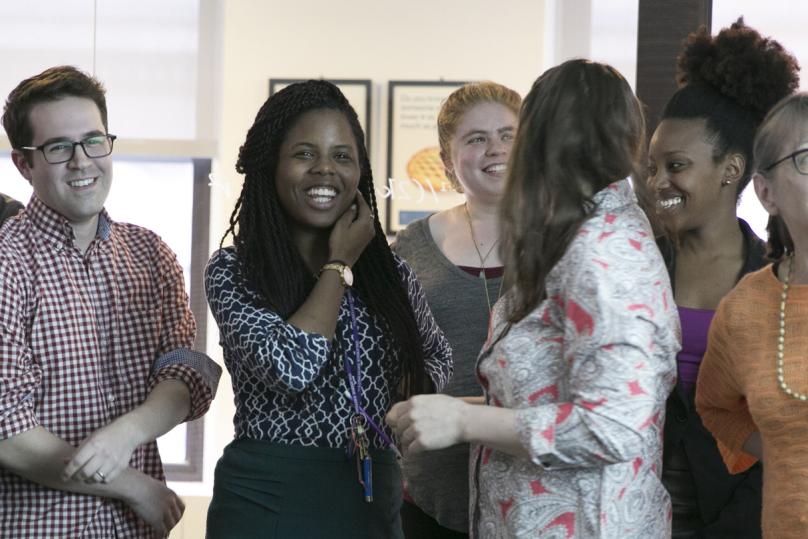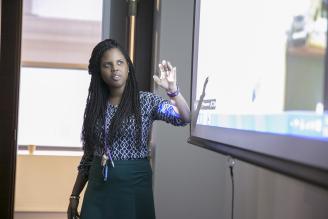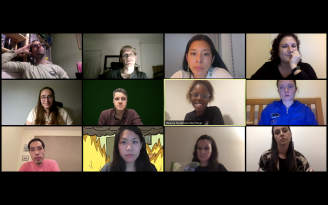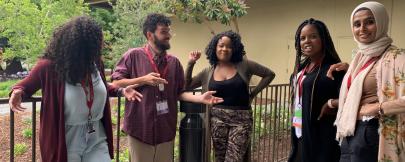
How MƒA helps Master Teacher Dwaina Sookhoo foster racial equity in her classroom, school, and community.
When MƒA Master Teacher Dwaina Sookhoo first started teaching mathematics at age 22, she was one of the few Black teachers in her school, and no one was talking about racial equity. “There was no push for it,” she recalls. “A lot of the teachers were white, and didn’t really think about it.”
Sookhoo, a New York City native, had found her calling a few years earlier while participating in a mathematics education program at Queens College. While math wasn’t her favorite subject in high school, she fell in love with teaching, and relished the opportunity to help her students the way her own teachers had helped her.

After being accepted into the MƒA fellowship early in her career, she soon gravitated to the increasing number of teaching-focused offerings she saw in the program—particularly courses that focused on the role race plays in the classroom.
“My first real exposure to thinking about equity was through MƒA,” Sookhoo says. In that course, she found a diverse group of peers who had “very honest conversations about how we felt within the MƒA community and in our schools, and what we wanted to do to make those communities stronger.” The following year, Sookhoo volunteered to co-lead a course focused on race with another MƒA teacher.
By the time the 2019-20 school year began, Sookhoo was teaching at the Academy for Young Writers in Brooklyn. She had joined the school’s existing equity team, but didn’t feel like they were making progress. “We had to reach numbers and specific data in terms of certain populations of kids,” she says. “It didn’t really feel personal to the school, or designed for our students and our staff.”
Drawing on the student-centered, discussion-based practices she learned through MƒA and other professional development programs, Sookhoo worked with a few of her colleagues and school administrators to create a new equity team at the school. By early 2020, the group had surveyed students about what equity looked like to them and zeroed in on several major initiatives for the coming semester, including the development of a clear school-wide equity policy and what Sookhoo calls “a more meaningful approach to discipline, where it wasn’t aggressive or punitive, but it still felt like a consequence to students.”
With the arrival of the COVID-19 pandemic that March, Sookhoo’s team focused on making remote learning more equitable for their school’s students, many of whom live in underserved areas with fewer financial resources. During the 2020-21 school year, despite drastically reduced funding, they formed affinity groups that met once a month to continue the conversations around equity.
To run productive discussions within the groups, Sookhoo turned to a format she had embraced through MƒA: the book club. “I'm a strong believer in having some kind of concrete resource like a book or an article as a starting point,” she says. “Whether you’re agreeing or disagreeing — as long as you're having a conversation, there's movement there.”

One of her colleagues, also an MƒA teacher, enrolled in a session Sookhoo led on Cornelius Minor’s We Got This! Equity, Access, and the Quest to Be Who Our Students Need Us to Be. “As a result, she felt more comfortable joining the school’s affinity groups and sharing her opinion,” Sookhoo recalls.
In addition to the affinity groups, the equity team also led several mandatory full-staff professional development meetings, including one where they played clips from Zoom interviews with students so that staff could hear students give their input rather than reading their responses in a survey. For Sookhoo, listening to students is the key to any meaningful effort to create equity: “Giving students the space to say what they need helps you become a more equitable teacher, because you’re taking the people you're trying to teach into consideration.”
Now in her ninth year of teaching, Sookhoo began working at the New York City Lab School for Collaborative Studies in Manhattan in the fall of 2021, and is excited to continue to implement what she learns through MƒA in her classroom. She also plans to continue leading book clubs and other equity-focused efforts at her new school, with the support of a core group of MƒA colleagues engaged in similar work.
“I feel like I have a ‘squad’ now,” Sookhoo says. “The conversations I’ve had, the vulnerability that I’ve experienced, and the comfort I’ve felt opening up, I’ve been able to bring not just to my own teaching, but to my department and school community as well.”
“Whether you’re agreeing or disagreeing — as long as you're having a conversation, there's movement there.”
